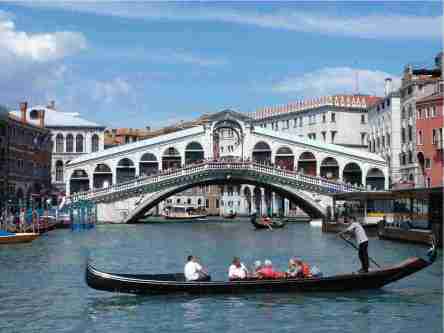Every bridge tells a story. While people cross and centuries pass they remain. Generations and fashions change but the job of a bridge is always the same. There are many ways of getting across and all types of bridges but Italians build theirs with style and grace, and above all materials that resist the ravages of man and nature.
If you are traveling to Italy you should cross as many as you can. Ponte Fabricio (Rome), Ponte Vecchio (Florence) and the Rialto (Venice) are good places to start. They are rightfully famous and attract a crowd but you can avoid those by choosing to cross early or late. Don’t hurry here. Hesitate, as you pass from one bank to the other and contemplate the views from either. Listen to the musician strumming a guitar and kindly decline the advances of nomadic pedlars. You’re in Italy now and adding your steps to those that have crossed before and will cross again.

Ponte Fabricus | Rome
Whoever said the more things change the more they stay the same probably had Rome in mind and the Isola Tiberina in particular. This small island of volcanic rock in the middle of the Tiber River played a crucial roll in putting Rome on the map. It’s here that Aesculapius, the god of medicine was worshipped, where ancient Romans waited to be healed outside his temple and where a hospital has been standing since 1548. The island itself was altered to resemble a ship in the 1st century AD and the Ponte Fabricio that links the island to the Jewish Ghetto is the oldest in the city.
It’s a popular crossing point and often lined with street vendors and musicians entertaining passersby. During the summer locals sun themselves on the embankment below while open-air cinema and food kiosks open at night along the riverside.

Ponte Vecchio | Florence
There are many bridges in Florence but Ponte Vecchio, is the one everyone wants to cross. It’s the oldest in the city and has spanned the Arno River since 1342. What makes it special are the workshops built on both sides of the bridge by butchers who once plied their trade here and discarded waste in the gaps at the center where tourists now line up to take photos. Above the eastern side of the bridge runs the Vasari Corridor that connects the Uffizi with Palazzo Pitti. It was completed in less than 5 months and used by Cosimo Medici to avoid the chaos below. A few years later in 1593 the butchers were evicted and replaced with jewelers who didn’t smell as bad. During World War II the Ponte Vecchio was the only bridge spared by the retreating German forces.
Ponte Vecchio is filled with tourists most of the day, half-admiring boutiques and in no hurry to get to the other side. The bridge is best viewed from the streets running along the Arno and neighboring bridges, which attract less attention. People gather on Ponte Santa Trinità, 150 yards down river, to watch the pastel colors of the Ponte Vecchio transformed at sunset. Ponte Alle Grazie, in the opposite direction, is farther away but offers good morning view and leads to lesser-known parts of Florence.

Rialto | Venice
The Rialto is in the center of Venice and connects the San Polo neighborhood with San Marco. There’s been a succession of bridges on this spot since the 13th century as the city grew in power and wealth. The original pontoon crossing was replaced with a wooden bridge later destroyed during a failed rebellion. The next structure collapsed and was substituted by a drawbridge depicted in local paintings.
A competition was held to replace it with something more substantial in 1524 and although Palladio and Michelangelo were among the participants a little known local architect was appointed six decades later. Antonio de Ponte (ponte coincidently means bridge in Italian) completed the project in less than three years using stone and a single 48-meter arch to span the Grand Canal. The steep steps are divided into three lanes the central of which is lined with shops reminiscent of the Ponte Vecchio.
It’s crowded at the best of times and only early mornings and late evenings provide relief from bridge-crazed tourists.The southern side is currently under restoration and partially covered in scaffolding making the steps even more crammed than usual. Head to the embankments below that run north and south of the bridge to admire the Rialto in peace .
Discover three remarkable cities
in one practical guide:
Moon: Rome, Florence & Venice
